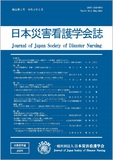Japanese
English
- 有料閲覧
- Abstract 文献概要
- 参考文献 Reference
- サイト内被引用 Cited by
要約
目的:本研究では、全国の看護基礎教育機関における、災害看護に関する教育の実態を調査し、教育課程別に比較検討することを目的とした。
方法:対象は看護基礎教育機関957校の学科長または教務主任。調査用紙を郵送し、匿名による回収を郵送で行った。選択回答は単純集計し、自由記載は計量テキスト分析を行った。
結果:有効回収率36.7%。災害看護関連科目の開講率は、全体で97.4%、大学のみ87.3%であった。大学以外は、ほぼ100%が必修科目の設定であった。大学と高等学校5年一貫校は1単位/15時間設定が約8割と類似した傾向を示し、それ以外は、1単位/30時間設定が9割以上であった。平均講義時間は13.37±9.21、平均演習時間3.90±5.12で、教育課程別の差異はなかった。災害看護経験のある専任教員の不足と授業時間数の不足、演習内容の検討の必要性が教育上の課題として挙げられた。
結論:災害看護関連科目は、開講率、必修科目設定率および単位数/時間数の設定の全てにおいて、大学と大学以外の教育機関の違いが示された。講義時間と演習時間は、教育課程による違いは示されなかった。災害看護経験のある専任教員の不足と授業時間数の不足、演習内容の検討の必要性が教育上の課題として挙げられた。
Purpose: The aim of this study was to investigate the current situation of education related to disaster nursing at basic nursing education institutions nationwide, and to examine and compare the individual education courses.
Method: The subjects of the research were the deans and academic affairs coordinators of 957 basic nursing education institutions. The survey forms were mailed to the participants and collected anonymously. The researcher used simple tabulation for multiple-choice answers and quantitative text analysis for free text.
Results: The effective response rate was 36.7%, and the rate of disaster nursing-related courses offered was 97.4% overall, and 87.3% at universities in particular. Excluding universities, most institutions had disaster nursing as a compulsory subject. As for the curriculum, approximately 80% of universities and 5-year high schools allocated 1 credit/15 hours to the subject, and more than 90% allocated 1 unit/30 hours. The average lecture time was 13.37±9.21 hours and the average training time was 3.90±5.12 hours; there were no differences depending on the curriculum. Educational issues were a shortage of full-time teachers with experience in disaster nursing, inadequate class hours, and the need to examine the content of training programs.
Conclusions: Regarding disaster nursing-related subjects, there were differences between universities and non-university educational institutions in all of the factors of the rate of offering the course, the rate of setting it as a compulsory subject, and the unit/hour settings. Lecture time and training time did not differ depending on the curriculum. Educational issues were a shortage of full-time teachers with experience in disaster nursing, inadequate class hours, and the need to examine the content of training programs.
Copyright © 2021, Japan Society of Disaster Nursing All rights reserved.


